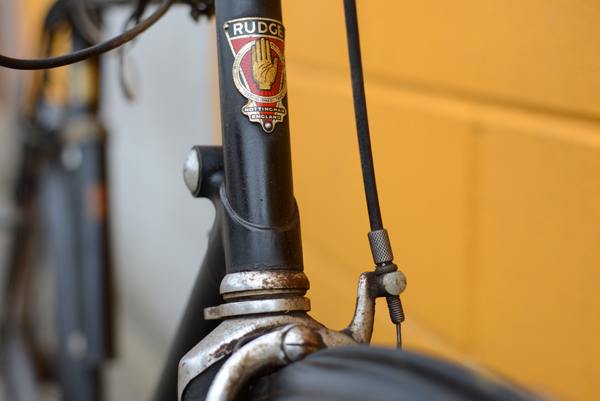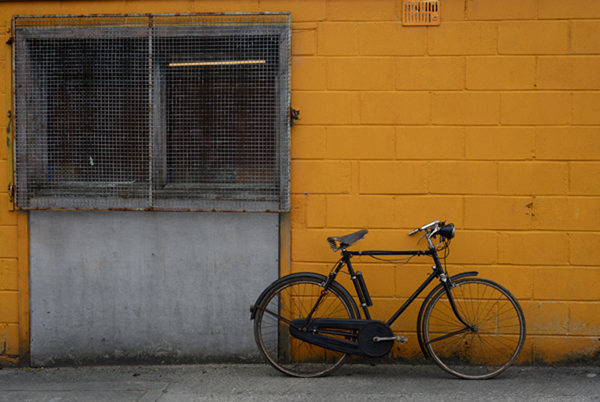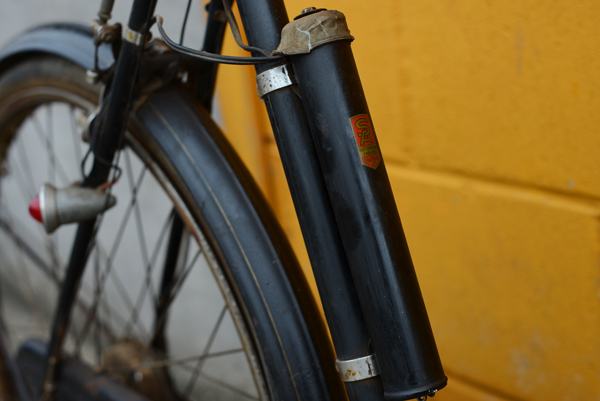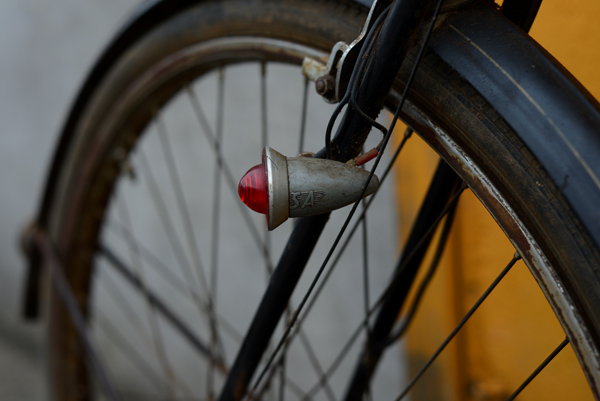Until recently I had not really considered the meaning of the Rudge headbadge. It was only a couple of days ago when, having spotted a lovely sports roadster with a full-colour version of the emblem, that it hit me. Is this the Red Hand of Ulster?
By now I have grown used to seeing renderings of the up-turned hand on flags and logos - the mystical symbol of Northern Ireland, appropriated, interestingly and confusingly enough, by both Loyalist and Republican groups, as well as by various non-sectarian organisations, clubs and the like. And now here it was on this bicycle.
I scanned my memory for what I recalled of Rudge history, but none of it had to do with Ulster. So I looked into it once again. Founded in Coventry, England by engineer Daniel Rudge, the company later merged with Birmingham-based Whitworth Cycle Co. to become Rudge-Whitworth Cycles (and later motorcycle manufacturer). Nothing geographically close to Northern Ireland here. Neither did the
old catalogues seem to offer any explanation. The one thing I did find acknowledging the link was the Rudge Ulster motorbike. That, however, was named after the 1928 Ulster Grand Prix race, won on a Rudge machine - an event which the headbadge precedes.
The Rudge sports roadster distracted me from the hand question with its many nifty features, such as this original Sturmey Archer Dyno Luxe battery pack, mounted on the seat tube.
Wired to the battery pack are the headlight and tail light, also Sturmey Archer branded. During this time period, it seems that manufacturers used dyno hubs, bottle generators and these dry battery packs simultaneously. I've often wondered what determined which method they chose.
Like a missing key to a vintage wheel lock, the definitive answer to the question of the Hand's origin may never be found. The most likely explanation seems to be that the
Rudge family (
edited to add: actually, the Whitworth family, as
it seems the logo came from their side of the Rudge-Whitworth merger) hailed originally from Northern Ireland and used the Red Hand symbol to commemorate this. However I also love
Jim Langley's thinking that the symbol meant "hand made." If only we could "talk to the hand" and ask!
Whatever the origin of the Rudge emblem - rendered in several versions on their headbadges and chainrings - it is a striking symbol, in particular when the bikes are spotted in Northern Ireland. And if anyone is in the market for a vintage Rudge roadster, this one can be had at
Gerald Deehan's Vintage and Antique Swap in Limavady.






It's not red. Googling it reveals only red hands, though the pattern is identical.
ReplyDeleteThe Rudge one is sometimes red. And the non-Rudge ones I see around are sometimes not red.
DeleteMy headbadge collection includes a version of the Rudge in your pictures above.
DeleteI have tried to find a decent version of the round Rudge badge in your link. So far no luck.
Fun to see these vintage bike "popups" with photos that I can run out and compare to my bikes and say, oh yeah, I've got that light, etc. Thanks! Jim Duncan
ReplyDeletePerhaps the battery pack was there as a "stand light".
ReplyDeletevsk
Several years ago I heard the former (American) Poet Laureate Robert Pinsky give a lecture, and at one point, after a question, he paused and said, "You know, everything has a story." He pointed to the emblem on the lectern, the university seal, he pointed to various things around the room, and wondered aloud about all those ordinary things we see every day, their stories and histories. I love it when people notice and wonder about stories!
ReplyDeleteI remember him as the translator of one of Milosz's works.
DeleteMy freshman year at Berkeley I took a class with Pinsky on American poetry (Frost, Stevens, Bishop, Bidart, Crane, Hass...). Great class. Pinsky truly had an infectious enthusiasm for poetry. I believe he was working on Milosz translations then. Though I took several other Slavic lit classes, I never took a class with Milosz. But I remember him for having the bushiest eyebrows on campus.
DeleteBefore a reading at Black Oak those eyebrows preceded him into the room.
DeleteOn this topic, I suppose that where you are you probably see a few of the Raleigh "Ulster" models, which do have a drive-side chainring machined into the form of a hand Do you know anything of the history of these bikes?
ReplyDeleteI have never seen a Raleigh Ulster model with a hand chainring; is it a different style from the Rudge chainring?
DeleteA question which makes me question my assumptions. The chainring I saw was on a Raleigh-headbadged roadster with "Ulster Sports" painted on the downtube. However, it did look just like the Rudge chainring (now that I've looked up what those look like), so maybe my red hand theory was wide of the mark.
DeleteWell, that question made me do research. And having done so, I think I was mistaken about Raleigh. But I discover instead that it seems Rudge were making some models named "Ulster", with the characteristic chainring. So maybe there is something in this red hand theory.
Deletethis guy http://www.oldbike.eu/museum/bikes-1800s/1894-1895/1895-rudge-whitworth-no-3-road-racer/ writes that the hand is from Whitworth and shows a few Whitworth ads, without Rudge, depicting the hand. still doesn't explain to me why they chose the hand as a logo, but it's definitely one of the more recognizable cycling logos around.
ReplyDeleteThanks, I missed the Whitworth connection.
DeleteFollow this link from a 1915 Rudge- Whitworth Catalog and you'll see the hand is red in that one. (bottom of the page)
ReplyDeletehttp://www.oldbike.eu/wordpress/?page_id=647
I've heard both the Red Hand of Ulster and "Handmade" story. Of the two I'd give more credit to the Red Hand of Ulster since "handmade" wasn't really a selling point at the turn of the last century. Infact, it was quite possibly the opposite since it (bicycles in general) was the beginning/middle of the industrial revolution. And handmade possibly was considered something that "poor" folks did cause they couldn't afford anything better.
Prior to speric's link, the oldest Rudge catalogue I'd seen was from 1910, when they had already merged with Whitworth. The hand appears on the cover in red on that one as well.
DeletePretty sure the handmade reference was a joke to start with, for all the reason you say. Funny how perceptions of handmade can change. When viewed in a positive light, I guess it would mean "expertly crafted," whereas in a negative light it would mean more like DIY. I keep meaning to write about this 1930s NI-made Tyrone Flyer, which is a little of both.
You are misdating the industrial revolution by a century.
DeleteEither when Rudge was created or when the featured bike was created there were enough people employed in metalworking that the meaning of handmade would have been clear. Pretty much anyone looking at a bike frame would have a very good idea what the production processes were and how much hand labor had gone into it.
The featured bike was made by human hands. Those hands my have used machines and large machines and it was all done in a factory setting. More was done with simple hand tools than you imagine. There were no robots that could spit out a bike frame. It's a handmade bike.
The " poor folks" concept is so ahistorical I hardly know where to begin. Social class was extremely well articulated in early 20th century UK. No one ever forgot for a moment their place in the class system. Everything one might do, including making a bike, buying a bike, riding a bike had significance in terms of class. The notion that class does not exist except when we interrupt our day to muse about "poor folks" is specifically American and quite recent.
I'm going to burn some more bandwidth because the "joke" line grates.
DeleteWhen I was a lad in the late 1960s I worked briefly in production control in an Industrial Revolution era dark satanic mill. My job was mostly gears for speedometers and tachometers. Those were made in series and fairly quickly but they were emphatically cut one at a time by a machinist. The machines did not run themselves. Setup, maintenance, sharpening took as much time as gearhobbing.
The job did also include making a variety of nameplates, coverplates, badges. I have a very good idea what making a Rudge headbadge entailed. A lot of hand operations. You are looking at pieces that were made a few hundred a month or at most a few thousand a month. Each piece is getting handled inspected and cared for repeatedly. We had the capability to make product as fine as the Rudge badge shown here but only did so when the customer really cared how their name was rendered. Most customers did not care. When looking at the sort of bike you show here it is massively evident that everyone whose hands touched the bike did care.
I still remember the day an already somewhat famous customer, Caroll Shelby, came to the plant. He showed up in greasy coveralls and dirty hands and walked straight past the suits. He wanted to talk to the machinists. He operated the lathes and mills and hobs himself because there was no other way to know how they had been maintained and what they were capable of. He showed the men where he wanted a thousandth, where he wanted a polish, how he wanted a file stroke. Shelby's work was thenceforth handled separately. No change in part number, no change in blueprint, not a word on paper. Totally different parts. Handmade. The level of motivation the machinists had when working on a Shelby order was palpable.
This notion that the production of industrial artifacts consists of a series of inside jokes is just bizarre. At best it speaks callousness alienation and ignorance. We still care about these old bikes precisely because the people who made them cared.
We live now in a world where product is designed at computer terminals and made by flesh robots no one ever sees. Pre-production samples fly back and forth until the designer feels the flesh robots are gettting it approximately right. The designer who imagines that he is somehow qualitatively different from his flesh robots is delusional. Both are just cogs in a machine. Owning or using such products makes the consumer another cog in the machine.
We like the old bikes. We appreciate the old bikes. Denigrating them as jokes or DIY projects makes no sense.
Anon 10:08 and 12:49. You misinterpreted my comment in several ways. I meant that the person suggesting the logo meant handmade had been joking, not that the idea of this being a handmade bike is a joke. Not enough bandwidth to comment further just now.
Delete"The designer who imagines that he is somehow qualitatively different from his flesh robots is delusional. Both are just cogs in a machine. Owning or using such products makes the consumer another cog in the machine."
DeleteGood observation.
The Shelby story was great. Unfortunately it's now a brand to be imprinted on the likes of Mustangs.
"What if the breath that kindled those grim fires, Awaked, should blow them into sevenfold rage,
ReplyDeleteAnd plunge us in the flames; or from above
Should intermitted vengeance arm again
His red right hand to plague us?"
Would that Whitworth be the same origin as the Whitworth threading that is found on a lot of older British vehicles? I have an old Land Rover that has some Whitworth-threaded bolts, which is a different thread than the usual standard British threading.
ReplyDeleteLooks like the old Allsopp brewery's symbol from Burton. Common symbol?
ReplyDeleteI think the headbadge is where the soul of a bike resides, especially if it's nice thick brass with lots of enamel or cloisonné work. I don't know how many badges I have imprisoned in a box under my bench but it's beyond dozens.
ReplyDeleteSome of them came off dead bikes that were beyond saving and I don't feel bad about them but the ones I filed, chiseled or drilled from the headtubes of living breathing bikes make me wonder what I'm really capable of...
My Rudge badge came off a 1960s 3spd I stumbled across clamped in the stand at the local university bike co-op, covered with beer bottle labels and sporting ape-hanger bars. I justified it by telling myself the old girl was doomed and the hooligan who was torturing her would neither notice or care... It's similar to the one in your photo but plain alloy with just black screen printing. I removed it by quickly pressing a sharp Philips screwdriver into the soft aluminum rivets and twisting till they gave up, all the while glancing over my shoulder and telling the bike not to make a sound. I calmly walked back out to my car with the badge throbbing in my pocket and my heart pounding in my chest.
The beautiful brass Batavus "B" I got last week by taking up a friends offer to buy a nice old 10spd mixte that got abandoned at his shop for $10 as long as I passed it on to someone and didn't just part it out. It still rode just as well after I got done with the hammer and pin punch as before (if you ignore the fact that it's merely a soul-less zombie bike that doesn't know it's own name anymore). How did I become this monster? I feel like the Hairy Wildman depicted on the badge itself, striding, club on shoulder looking for the next tender morsel to wolf down.
I sometimes get the box out and look at my trophies, the lovely cloisonné Fuji badge from the bent "Special Road Racer", the Apollo badge that looks like it's from the 1930s, it has the head of a young god wearing a laurel wreath and looking noble. It lives in the dark under my bench now too. Then there are the ones I've forgotten, where did the "Londoner" badge come from? It has an amazing bas relief of Big Ben stamped on it, you'd think I'd remember that one. Maybe I'm suppressing that memory. Don't ask me where all the Schwinn ovals and Raleigh Herons came from either. Dim recollections of bike racks outside poorly lit dormitories surface but nothing stands out.
I try to stop, I ask myself how I would feel if someone did that to one of my bikes but it doesn't make any difference. I am beyond help.
My name is Spindizzy and I steal headbadges. Please stop me before I take another bikes soul...
A wonderful obsession.
DeleteOne for which there is no cure.
Least none I can think of anyway.
OK, just so everybody knows, I don't really murder bikes for their badges. I can't believe how creepy I still feel after writing that...
ReplyDeleteBbbrrrrrr...
Spindizzy the bikopath.
ReplyDeleteLast year I did some brief research on the use of the Red Hand of Ulster by Rudge-Whitworth. I spent a few hours looking into the history of the firm, contacting the Rudge (motorcycle) owners club in the process, but after a while I came to the conclusion that, frustratingly, no-one knows the answer. I couldn't find any documented evidence of a connection between the company and the Ulster region. It is possible that one of the founders had Irish roots (all the founding directors were born in the English Midlands, but I didn't trace their family trees) but it is equally possible that one of them, when looking for a logo for their new company, just saw the image somewhere and thought it looked good. It is almost certainly a copy of the red hand of Ulster but if the company founders had never travelled to that region they may not have realised its significance.
ReplyDeleteThe logo is also famously found on high-end spoked sports car wheels, as the company later diversified into that field. An earlier comment mentioned Raleigh, there is a connection there too as Rudge bicycle production was eventually bought out by Raleigh who moved the factory from Coventry to Nottingham.
The Rudge 'hand' front chainring is a thing of beauty, although not all their bikes had it. You can find photos of it on Google images.
This is just a guess but the red hand appears on the coat of arms of Baronets so it may have been picked as an aristocratic symbol rather than a direct link with Ulster.
Deletethe Hand of Glory ;-)
ReplyDelete